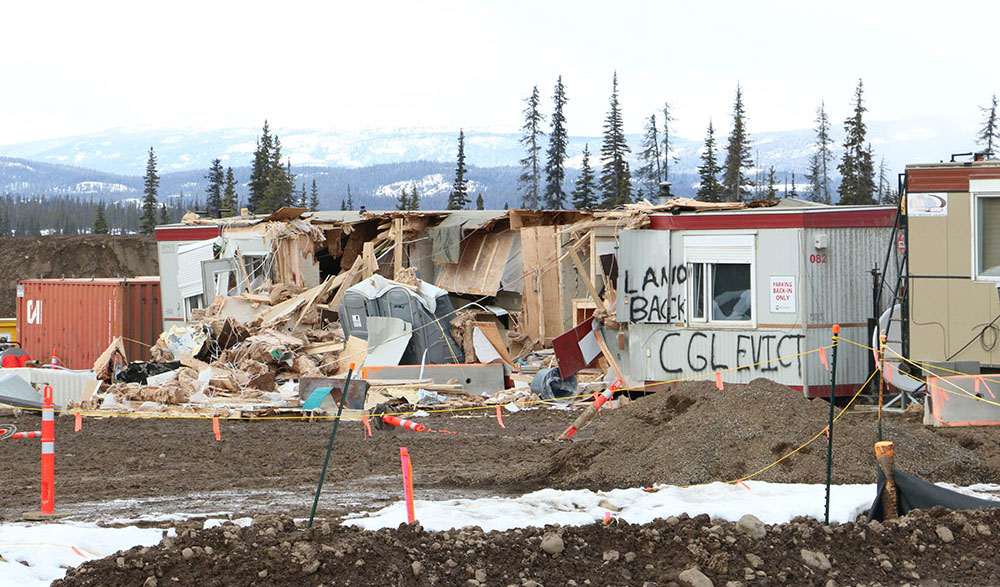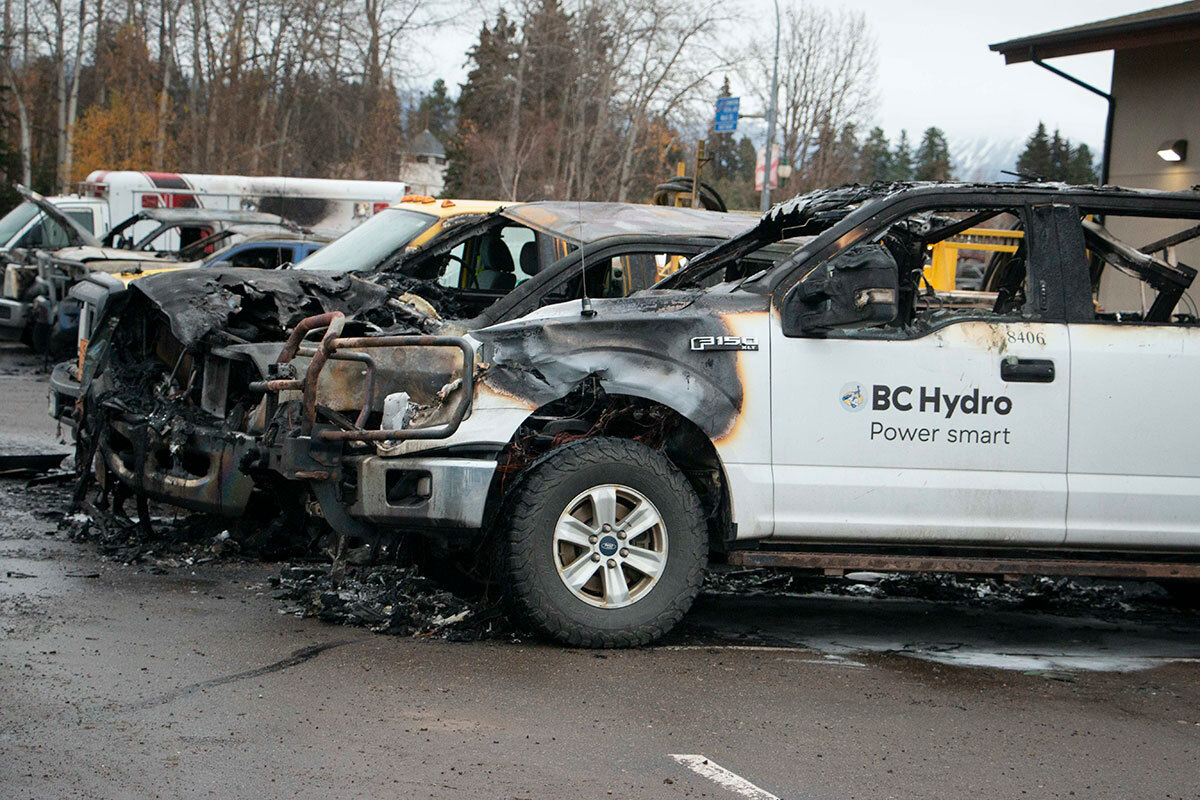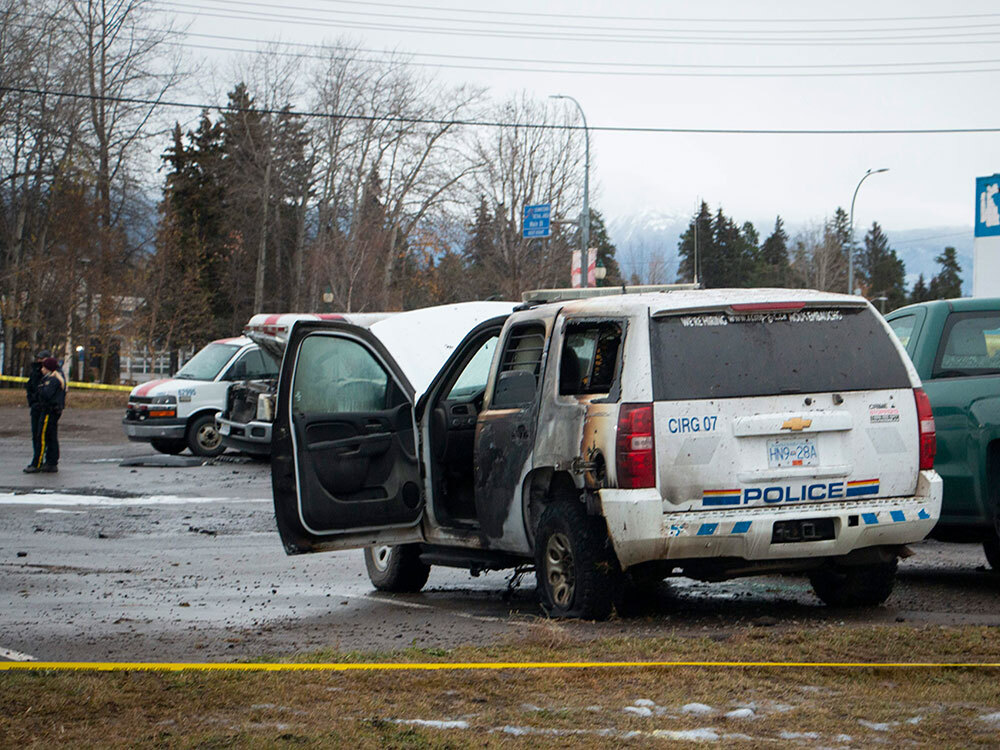When eight vehicles were set on fire in a Smithers hotel parking lot a few days before Halloween, it seemed everyone had a theory.
Many jumped to connect the blaze with the volatile pipeline dispute that has plagued the region for the past four years. Smithers is on Wet’suwet’en territory and about 65 kilometres north of a section of the 670-kilometre Coastal GasLink pipeline route. It’s been one of the communities most heavily impacted by conflict over the project, which has involved blockades, arrests and the involvement of large RCMP forces.
Four of the vehicles set ablaze belonged to the RCMP’s Community-Industry Response Group, also known as C-IRG, which it formed in 2017 specifically to address conflict over resource extraction.
Some media were quick to connect the early morning fire, which police described as arson, to ongoing pipeline opposition by Wet’suwet’en hereditary leadership and their supporters, which has resulted in several high-profile police actions in recent years.
They also suggested links to an attack reported by Coastal GasLink workers at one of its worksites in February.
On the other side of the fence, firing shots mainly from social media, were those who believed that, for the second time in under a year, RCMP had conducted a false flag operation — put bluntly, that police had torched their own vehicles to gain support for their role in the pipeline conflict.
There was, it seemed, no middle ground. In the absence of information, people filled in the gaps with rumours, speculation, conspiracies and prejudices.
The day after the apparent arson, the Vancouver Sun ran a story describing a “community on edge.” In it, Smithers Mayor Gladys Atrill called for calm in the face of so many unknowns.
“I understand how people get to those conclusions,” Atrill told the Sun. “It’s just my view at this point, while the RCMP are early in the investigation, we’re not helping ourselves by speculating or making the situation more dramatic than it already is.”
But speculate they did. The Sun went on to quote a resident — the only other interview in the story — who described an “underlying sentiment that the arson was terrorism” related to the pipeline issue.
“Eco-terrorism,” to borrow the phrase used by Skeena MLA Ellis Ross in an interview with CTV News.
https://t.co/6MsBnJCiCt nothing was done when pipeline workers were terrorized outside of Houston BC and now the violence has migrated inside the town of Smiters. Is this enough to change BC’s soft on crime program?
— Ellis Ross (@ellisbross) October 26, 2022
Amid the speculation, both sides asked one question: Whatever happened to the RCMP’s investigation into the Feb. 17 pipeline worksite attack?
It’s been almost 10 months since news broke that an estimated 20 masked assailants arrived shortly after midnight at a remote worksite where Coastal GasLink is now drilling under the Morice River, allegedly chasing off workers with axes and using the company’s own equipment to cause millions of dollars in damage.
In the days that followed, I travelled the two hours from Smithers to the worksite, located 65 kilometres down a rough resource road south of Houston. RCMP provided an escort to view the wreckage and arranged an interview with Chief Supt. Warren Brown, who was overseeing the investigation. It was the only interview the force has provided me in my three years of covering the pipeline conflict.

Despite there being only one road in or out of the area, no charges have been laid and RCMP have not said if suspects have been identified. Indeed, they have said very little at all.
At the time, RCMP said it was dedicating 40 investigators to the case. It increased patrols on the Morice forest service road, where a camp established by members of the Wet’suwet’en Gidimt’en Clan became the subject of constant surveillance.
For the first time since the conflict first boiled over in early 2019, police began entering the camp, walking through multiple times a day and sometimes at night. They told occupants they had found a connection between the encampment and the Feb. 17 attack at the drill site, located 20 kilometres further down the Morice road.
Costs for policing the Morice, obtained through freedom of information laws, escalated early this year. In the three months spanning the mid-February attack, the force spent $4.5 million — roughly double what it spent in the nine months prior, between April and December last year.
But if the dozens of investigators, increased surveillance and millions of dollars spent have shed any light — or revealed a connection between camps on the Morice and the worksite attack — the RCMP has never provided any evidence of it. Requests for an update are repeatedly met with a standard response: “The investigation is ongoing.”
In the wake of last week’s fire, I reached out to RCMP again and requested interviews on both the drill site incident and the recent arson, suggesting now might be an appropriate time to provide an update.
Again, they declined.
“I have been in contact with the investigative team and at this time we cannot accommodate an interview,” came the now-predictable response from an RCMP spokesperson. “The investigation is ongoing and as it progresses the opportunity for an interview may become available. More details may be released as they become available.”
As another dangerous event with possible links to the pipeline conflict brings Smithers back into the spotlight, and as opposition MLAs like BC Liberal Leader Kevin Falcon jump to the defence of “resource-dependent communities,” the information void is filled with speculation.
Unacceptable. The continued violence and harassment of resource-dependent communities has to stop and there must be consequences for those defying law and order and endangering the lives of British Columbians. #BCpoli #Smithers https://t.co/zQQWJj16iD
— Kevin Falcon (@KevinFalcon) October 26, 2022
Smithers isn’t a prop for politicians and backdrop for the pipeline conflict. It existed for nearly a century before pipelines were ever proposed for our region. The town was founded in 1913 by the railway, grew with forestry and is now a popular tourism destination, with extensive mountain bike trails, a ski hill and a thriving music scene.
It’s the birthplace of the egg carton, home to Grammy-award-winning musician Alex Cuba and boasts a sushi restaurant that Liam Neeson once raved about on The Daily Show.
And, of course, it’s where the Wet’suwet’en, who flourished here for millennia before any of these things arrived, first launched the groundbreaking Delgamuukw-Gisday’wa court case that would forge a new path for Indigenous rights in Canada.
As a community, we are so much more than ground zero for a pipeline dispute.
But you wouldn’t know that from reading the National Post, which linked the recent arson to “enviro-violence [in] B.C.’s pipeline country.”
The National Post got many details wrong, but it made an important point: while Wet’suwet’en and supporters who blocked access to the pipeline route in defiance of a court injunction issued to Coastal GasLink have been clear about who they are and their intentions, whoever co-ordinated the attack in February has stayed quiet.

Apart from violence, it’s the one thing that distinguishes the drill site attack and recent arson from anti-pipeline protests in the Morice area: no one has taken responsibility.
In the days following the February attack, Wet’suwet’en hereditary leaders were quick to distance themselves from the destruction. “Our Elders, Dinize and Tsakë’ze [Chiefs] continue to state that we do not support violence,” the nation said in a statement.
And yet media reports lump together burning police cars and worksite destruction with ongoing — and peaceful — pipeline opposition. It sends the message that the violence is ultimately the result of Wet’suwet’en hereditary leadership asserting its authority over the territory.
And as the RCMP remains silent, the message is amplified in a dangerous echo chamber.
What the RCMP has said is that the recent Smithers arson, which was reported about 4:30 a.m. on Oct. 26, appeared to be “a targeted attack on emergency services vehicles.” It specifically pointed to the police vehicles and an ambulance.
When asked how police determined the ambulance was a target, given it appeared only slightly singed, an RCMP spokesperson declined to explain.
“I have no further details on the ongoing investigation,” came the response.
As our national police force faces a critical lack of trust, it’s not hard to understand why some might jump to conspiracy theories when the RCMP refuse to provide basic details about what occurred.
The public deserves an update, no matter how small, on what the RCMP knows about the Feb. 17 attack on the Coastal GasLink drill site. Its silence simply increases fears, suspicion and rumours — fuelling calls for even more policing. ![]()
Read more: Indigenous, Rights + Justice, BC Politics
















Tyee Commenting Guidelines
Comments that violate guidelines risk being deleted, and violations may result in a temporary or permanent user ban. Maintain the spirit of good conversation to stay in the discussion.
*Please note The Tyee is not a forum for spreading misinformation about COVID-19, denying its existence or minimizing its risk to public health.
Do:
Do not: